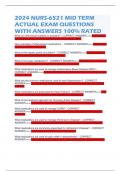Exam (elaborations)
2024 NURS-6521 MID TERM ACTUAL EXAM QUESTIONS WITH ANSWERS 100% RATED
- Course
- Institution
2024 NURS-6521 MID TERM ACTUAL EXAM QUESTIONS WITH ANSWERS 100% RATED 2024 NURS-6521 MID TERM ACTUAL EXAM QUESTIONS WITH ANSWERS 100% RATED 2024 NURS-6521 MID TERM ACTUAL EXAM QUESTIONS WITH ANSWERS 100% RATED 2024 NURS-6521 MID TERM ACTUAL EXAM QUESTIONS WITH ANSWERS 100% RATED 2024 NURS-6521 MID ...
[Show more]



